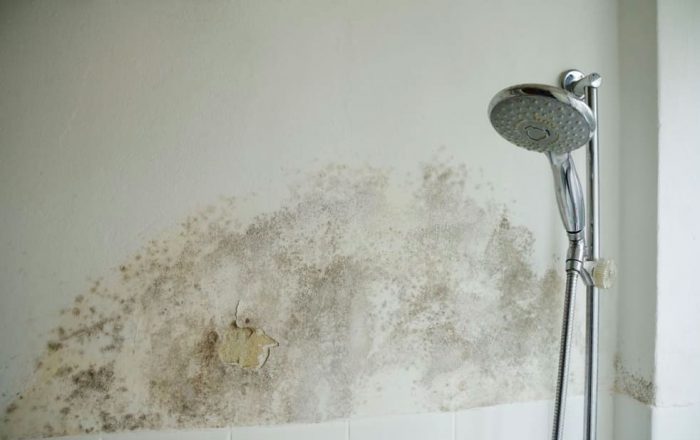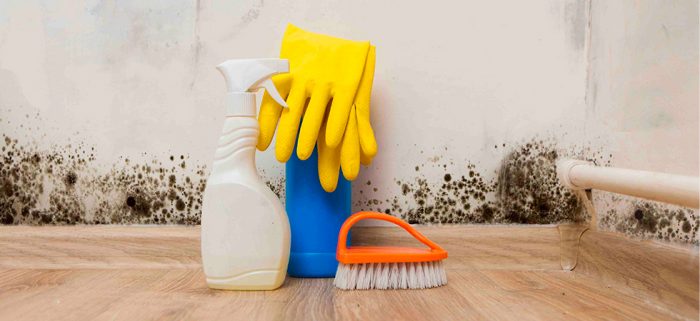The Ultimate Guide to Mould

What is Mould?
Mould is a living organism, belonging to the fungi family. It is a complex organism, genetically distinct from bacteria, mould occurs naturally and has the ability to spread and grow, given the appropriate conditions.
Mould is distinct from many other plant-based living organisms as it is heterotrophic. Essentially this means that mould is not capable of producing its own food source like many plants can. Instead, mould requires nutrients from other organic matter in order to survive and grow – it’s unpleasant to imagine, but untreated mould is ‘eating’ it’s way through your home!
Although mould spores can become airborne and exist without detection, you will typically see mould appearing as a black or dark brown discolouration, once it has found a suitable location.

What conditions result in mould growth?
- Moisture
- A ‘food’ source (any organic material)
- The right temperature range, out of UV light exposure
- Spores (Reproduction)
When these conditions are suitable, mould will grow and spread unhindered. The major concern is how easy it is to satisfy these conditions in homes and work spaces, without realising it.
Where does mould occur
There are plenty of hotspots around your home that provide the ideal habitat for mould to survive and flourish. One of the biggest concerns about mould growth in your home is that it often occurs out of sight and may go undetected for extended periods of time. Ideally you should undertake a thorough mould inspection of your property every 6 months in order to catch mould breakouts early, before the damage becomes too severe.
Here is a list of common places that mould will occur, including some areas that you might not check very often:
- Basements, cellars and garages
- Behind or kitchen sinks
- Behind or around laundry sinks
- Bathroom walls and ceiling
- Carpet and underlay (Check after spills or wet feet)
- Storage areas, particularly if there is paper
- Wall recesses
- Window sills and frames
When is the worst time for mould?
Unfortunately, mould can occur year round and cause severe damage that is difficult to treat without professional help.
Winter is typically the time where we see the spread of mould become most prevalent. This is due to a number of contributing factors, both environmental and lifestyle related. These include:
- Increased humidity levels indoors due to heating
- Less exposure to sunlight
- Drying clothes inside
- Window condensation from temperature differentials between inside and outside
- Increased rainfall and leakages that may go unnoticed in certain parts of the home
Although it necessary to keep an eye out for mould year round, it pays to be especially vigilant between May-September on the Eastern seaboard of Australia.

Why does mould occur?
Quite simply, mould occurs because it is allowed to. As with any living organism, certain conditions are required for mould to survive and grow, as is the case with any living organism.
DIY Mould Prevention
Take action to prevent mould occurring
When it comes to mould in your home or business, there is absolutely no doubt that prevention is better than cure.
Given the potential damage that mould can cause to your property it is worth taking steps to prevent the occurrence of mould as best you can.
By taking action with these simple steps, you can reduce the chance of being affected by mould in your home:
Let in a breath of fresh air
Whenever possible, open all doors and windows in your home to allow maximum fresh airflow through the house. This helps to naturally dry out any excess moisture that may occur, whether it’s from rain or leaking from pipes. Also remember to open up any internal doors and move furniture and major appliances from their normal position in case moisture build up underneath or behind.
Maintain a regular cleaning routine throughout the entire premises
Dust and grime left to accumulate around the house are the perfect catalyst for mould spores to multiply and breed.
Don’t neglect the little things like vacuuming, sweeping and mopping – otherwise you might be contributing to mould growth right under your nose.
Let the light in
Ultraviolet light is known to prevent and even kill mould spores completely. Make sure you get as much sunlight in as possible, and even remove the curtains completely during the day to maximise the exposure.
Regularly monitor internal humidity
Indoor humidity can be a big contributor to the occurrence of mould growth, so if this is a concern in your home, it might be worth investing in a humidity monitoring device to keep an eye on the situation. One of the biggest culprits behind high humidity in your home is often your air-conditioning unit, so make sure it has been recently serviced and inspected.
Home Ventilation Tips
It is vital that you take every effort to ensure your home receives maximum ventilation in order to reduce the risk of mould. Heat and moist air lead to condensation, which an result in mould.
Here are some simple steps to check your home ventilation and maximise airflow:
- Check that the exhaust fans in the bathroom and the kitchen are functioning properly. Remove dust filters and clean any build-up of grime thoroughly.
- The biggest contributors to moisture that you and your family create are hot baths/showers and cooking. Make sure all windows and fans are running when bathing and cooking to reduce stagnant moisture forming.
- Ventilation includes internal airflow too. Don’t overfill cupboards and leave them closed for extended periods. Allow room for air to flow behind furniture and always dry your clothes outside where possible.
The Science Behind Mould
Mould is actually quite a complex organism. Having a good understanding of the science behind it can help you reduce the risk of having a mould outbreak in your home, as well as knowing how to deal with it if it does appear.
A scientific explanation of mould
Mould spores are considered neither a part of the animal or plant kingdoms. Instead, they belong to the fungi kingdom, based on the multicellular structure and the fact that they do not need to create their own food source like plants do through photosynthesis. Hence, sunlight is not only unnecessary for mould to survive, but actually kills mould spores.
In fact, on a cellular level, mould is actually probably more closely related to animals than plants.
Just like all living organisms, mould still requires a food source to grow. Whilst mould doesn’t “eat” things in the strict sense of the word, it does produce complex enzymes that serve as a digestive mechanism which are released into the environment where the mould spores are present. This allows the mould to absorb the necessary nutrients required to thrive.
The bad news is that in a lot of cases, the mould will survive by consuming just about any kind of organic matter and moisture available, anywhere in your home.
By understanding what mould is and how it forms, survives and thrives you can be better prepared to identify and prevent any outbreaks in your home.
